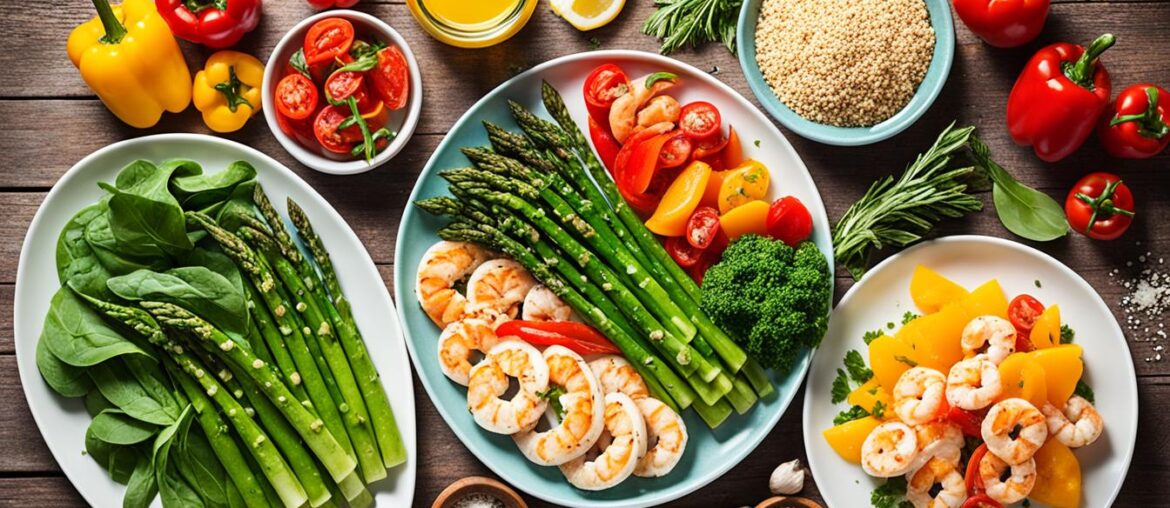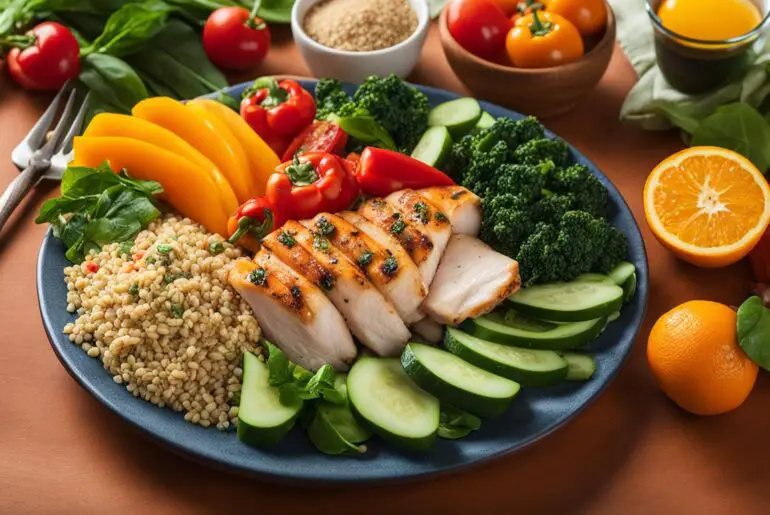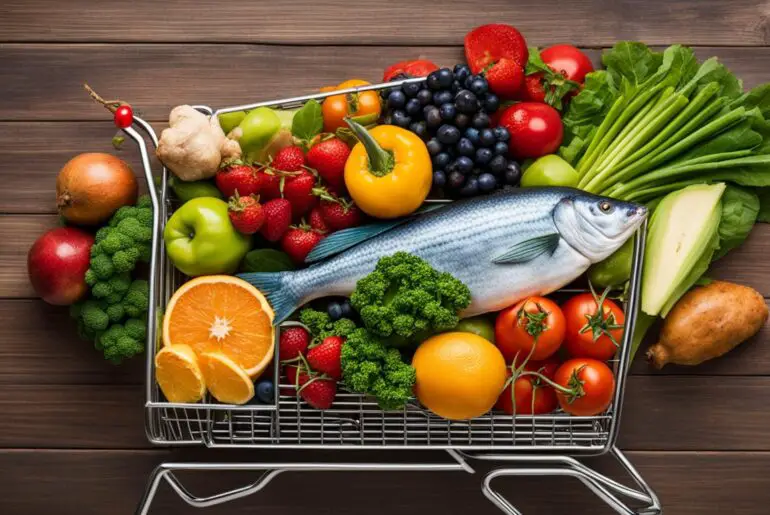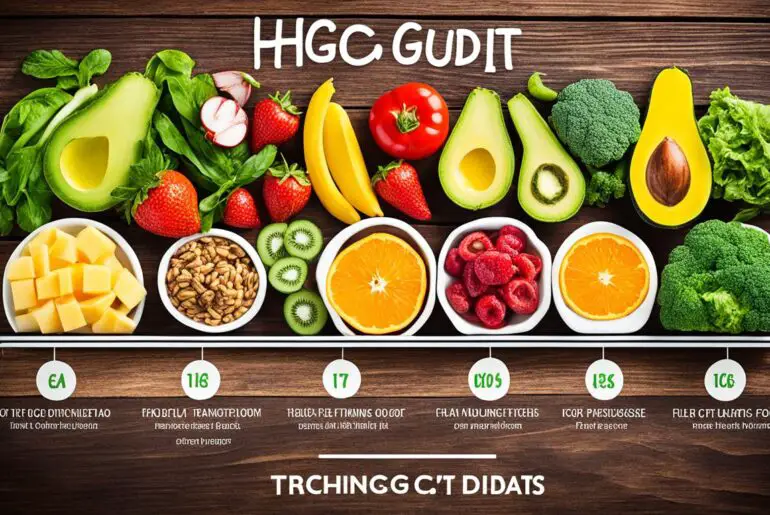Did you know that following a gluten-free diet can be a game-changer for individuals on the HCG diet? A staggering 1 in 133 Americans suffer from celiac disease, an autoimmune disorder triggered by gluten consumption. For those looking to combine the benefits of a gluten-free lifestyle with the HCG diet, we present the ultimate Gluten-Free HCG Diet Food List. This comprehensive guide is designed to help you navigate your weight loss journey while adhering to a gluten-free diet.
Key Takeaways:
- Choosing a gluten-free HCG diet can benefit individuals with celiac disease or gluten sensitivity.
- The Ultimate Gluten-Free HCG Diet Food List provides a comprehensive guide for a gluten-free HCG diet plan.
- The food list includes proteins, vegetables, fruits, starches, and condiments that are gluten-free and suitable for the HCG diet.
- Following the gluten-free HCG diet allows individuals to achieve their weight loss goals while maintaining a gluten-free lifestyle.
- By incorporating the recommended foods from the food list, you can create delicious and satisfying meals while on the gluten-free HCG diet.
What is the HCG Diet?
The HCG diet is a renowned weight loss protocol first developed by Dr. A.T.W. Simeons. This innovative diet incorporates the use of Human Chorionic Gonadotropin (HCG), a hormone that aids in shedding unwanted pounds. The HCG diet involves different phases to maximize results and promote a healthy lifestyle for long-term success.
One of the key phases of the HCG diet is the loading phase, where individuals consume ample calories while commencing HCG injections. This is followed by the fat burn phase, during which individuals are restricted to 500 calories per day, supported by the powerful effects of the HCG hormone. The hunger-suppressing properties of HCG help individuals adhere to the low-calorie intake while promoting fat burning and inch loss.
Many individuals have achieved remarkable success in their weight loss journey through the HCG diet. The combination of calorie restriction and the hormone’s effects contributes to the diet’s effectiveness and its popularity among those seeking to shed excess pounds.
Incorporating HCG into the diet plan allows individuals to experience accelerated weight loss, transforming their bodies and boosting their self-confidence. The HCG diet offers a comprehensive approach to weight loss, addressing both physical and psychological aspects of the journey.
Why the HCG Diet Works
The HCG hormone plays a vital role in the effectiveness of the diet by facilitating fat burning while minimizing muscle loss. By harnessing the power of HCG, the diet helps individuals achieve significant weight loss without compromising lean muscle mass.
During the fat burn phase, the HCG hormone works to suppress appetite, making the reduced calorie intake more manageable. This not only aids in weight loss but also helps individuals develop healthier relationships with food and maintain a calorie-conscious mindset even after completing the HCG diet.
The HCG diet is a proven method for those seeking visible and long-lasting weight loss results. The unique combination of calorie restriction and hormone support sets it apart from other diet plans, making it an appealing option for individuals looking to transform their bodies and regain control of their health.
Understanding the Phases of the HCG Diet
The HCG diet consists of several distinct phases that work together to ensure optimal weight loss and long-term weight maintenance. These phases include:
- Loading phase: This initial phase involves consuming high-calorie foods while beginning HCG injections to prepare the body for the subsequent stages.
- Fat burn phase: During this phase, individuals adhere to a strict 500-calorie daily intake while continuing with HCG injections, promoting rapid fat burning and subsequent weight loss.
- Maintenance phase: In this phase, calorie intake gradually increases, and individuals transition into a balanced diet while remaining conscious of sugar and starch intake.
- Long-term maintenance phase: The final phase involves integrating the principles learned during the HCG diet into a sustainable, healthy lifestyle. Individuals continue to prioritize mindful eating and regular exercise for maintaining long-term weight loss.
| Phase | Description |
|---|---|
| Loading Phase | Consuming high-calorie foods while starting HCG injections |
| Fat Burn Phase | Restricting calorie intake to 500 per day while continuing HCG injections |
| Maintenance Phase | Gradually increasing calorie intake and adhering to a balanced diet |
| Long-term Maintenance Phase | Continuing healthy habits for sustained weight loss |
The HCG diet is a comprehensive weight loss program that combines hormone support with calorie restriction to achieve visible results. With its distinct phases and focus on sustainable lifestyle changes, the HCG diet offers individuals a pathway to successful weight loss and lasting transformation.
Phase 1 – Gorging/Loading
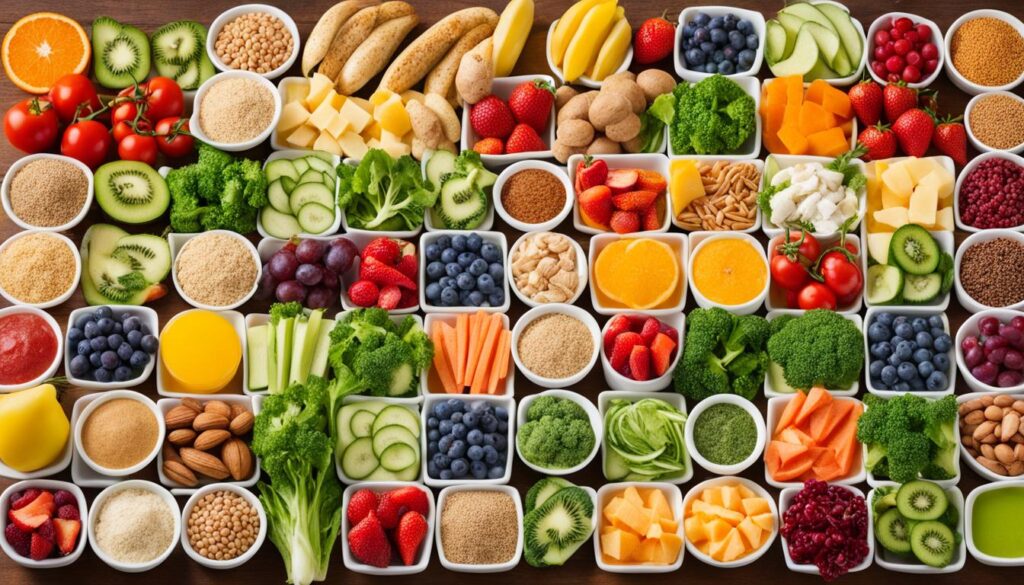
In the HCG diet, Phase 1 is known as the gorging or loading phase. This phase plays a crucial role in the overall success of the diet by helping to prevent extreme hunger pains during the first week of the program. During this phase, individuals are instructed to eat as much fatty and oily foods as possible while starting the HCG injections.
This phase may sound counterintuitive, but gorging/loading serves a specific purpose. By consuming high-calorie, high-fat foods, the body is essentially primed to transition into the fat burn phase that follows. It helps to increase the body’s fat stores, which will be utilized for energy during the subsequent phases of the diet.
The gorging/loading phase can be challenging, as individuals need to eat until they feel sick. It’s important to focus on foods that are high in fats and oils, such as cheese, peanut butter, avocados, and fried foods. This phase typically lasts for two days, and it requires a level of commitment and discipline.
I remember feeling overwhelmed during the gorging/loading phase. It was difficult to eat so much food, especially since I was used to practicing portion control. However, I understood that this phase was an essential part of the diet and would set the stage for the following phases. It was challenging, but it was worth it in the end.
The gorging/loading phase helps to prepare the body for the subsequent fat burn phase, where individuals consume a restricted calorie diet while taking HCG injections. It is important to follow the guidelines provided by the HCG diet protocol and not skip this phase, as it contributes to the overall effectiveness of the diet.
| Food Recommendations during Gorging/Loading Phase |
|---|
| High-fat dairy products (cheese, cream, butter) |
| Fatty meats (beef, pork, lamb) |
| Nuts and nut butter |
| Fried foods |
| Avocados and olives |
| Salad dressings with high-fat content |
The gorging/loading phase requires a temporary departure from the usual dietary restrictions and can be mentally challenging. However, it is an essential step toward achieving successful weight loss results with the HCG diet. By adhering to this phase, individuals set themselves up for a smoother transition into the subsequent phases of the diet.
Phase 2 – Fat Burn
The fat burn phase of the HCG diet is a crucial period in achieving your weight loss goals. During this phase, lasting for 21 days, you will be consuming only 500 calories per day while using the Nasal Spray. It may seem challenging, but the results are worth it.
In this phase, your diet will mainly consist of lean proteins to fuel your body’s fat-burning process. Opt for options such as beef, chicken breast, white fish, and shrimp. These protein sources are low in calories and high in nutrients, making them ideal for your fat burn phase.
Fruits and vegetables are also allowed in specific quantities. Incorporate fresh and colorful produce like apples, oranges, strawberries, broccoli, and spinach. These will provide essential vitamins, minerals, and fiber to support your overall health during the fat burn phase.
It’s vital to avoid starches and high-carb foods during this phase, as they can hinder your progress. Focus on keeping your carbohydrate intake low to stimulate fat mobilization and maximize weight loss.
The HCG hormone plays a crucial role in the fat burn phase. It helps mobilize fat stores, allowing your body to utilize them for energy. This hormone, when combined with the low-calorie diet, promotes efficient weight loss and helps you overcome plateaus.
By following the specific guidelines of the fat burn phase, you will ignite your body’s fat-burning engines and witness transformative weight loss results.
Allowed Foods on the HCG Diet

The HCG diet allows for a specific list of foods that are allowed to be consumed during the diet. These include proteins such as lean meats, chicken breast, and seafood. Vegetables like broccoli, spinach, and cucumbers are also allowed. Fruits such as apples, oranges, and strawberries can be consumed in limited quantities. Starches and high-carb foods should be avoided, as well as sugars and processed foods. The allowed foods provide individuals with the necessary nutrients while keeping calorie intake low.
List of Allowed Foods on the HCG Diet
| Proteins | Vegetables | Fruits |
|---|---|---|
| Lean meats | Broccoli | Apples |
| Chicken breast | Spinach | Oranges |
| Seafood | Cucumbers | Strawberries |
In addition to the proteins, vegetables, and fruits mentioned above, individuals on the HCG diet can also consume specific condiments and seasonings in moderation. Some examples include mustard, vinegar, garlic, and herbs. It’s important to read labels and check for hidden sugars or ingredients not allowed on the diet.
By following the allowed foods list on the HCG diet, individuals can enjoy a variety of nutritious options while working towards their weight loss goals. It’s essential to combine these foods in a balanced manner and consult with a healthcare professional before starting any new diet plan.
What to Avoid on the HCG Diet
When embarking on the HCG diet, it’s important to be mindful of the foods and products to avoid to ensure the best results. Here are some key things to steer clear of:
- Avoid oils found in everyday products like shampoos, lotions, toothpaste, and deodorants. These oils can interfere with the HCG diet and affect your progress.
- Liquid makeup should be avoided as it may contain ingredients that could hinder your weight loss journey. Instead, opt for mineral-based cosmetics that are less likely to interfere with the diet.
- To prevent water retention, it’s crucial to avoid sunburn. Excessive exposure to the sun can cause your body to hold onto water, which can impact your weight loss efforts on the HCG diet.
- While exercise is generally encouraged for a healthy lifestyle, excessive exercise during the HCG diet may put stress on your body and hinder weight loss. It’s best to engage in light to moderate physical activity and consult with a healthcare professional for guidance.
- Massages are generally relaxing, but they can also stimulate blood flow and potentially interfere with the HCG diet. It’s advisable to avoid deep or vigorous massages during this time.
By avoiding these foods and products, you can optimize your HCG diet experience and maximize your chances of achieving your weight loss goals.
Foods and Products to Avoid on the HCG Diet
| Foods | Products |
|---|---|
| Oils found in shampoos, lotions, toothpaste, and deodorants | Liquid makeup |
| Sunburn | Excessive exercise |
| Deep or vigorous massages |
Plateau Breakers
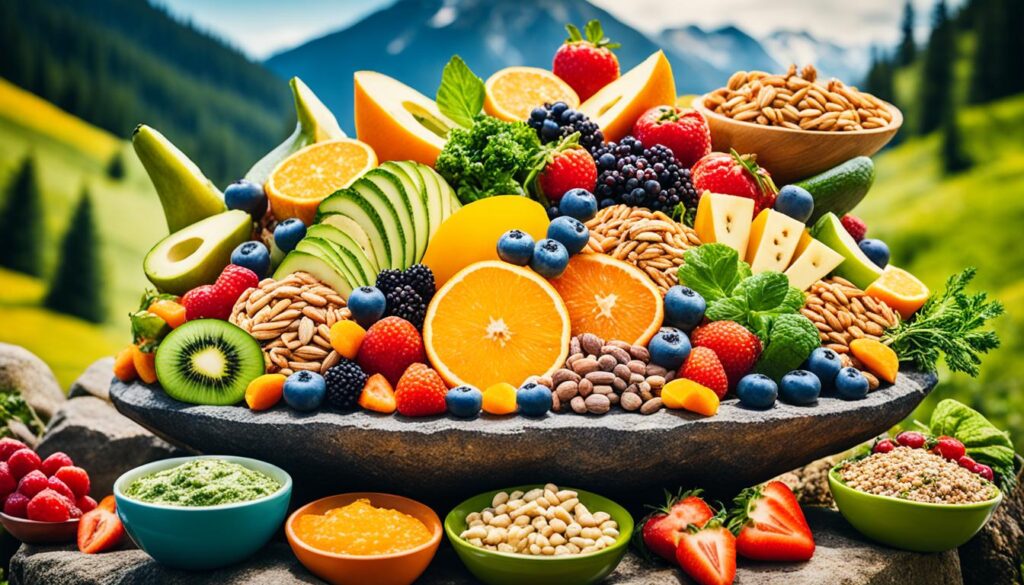
In some cases, individuals on the HCG diet may experience a plateau in their weight loss journey. Plateau breakers are strategies that can be used to overcome this plateau and continue losing weight.
Increasing Water Intake
One effective plateau breaker is to increase water intake. By staying hydrated, you can support your body’s metabolism and promote weight loss. Aim to drink at least 8-10 glasses of water per day.
Increasing Protein
Another strategy is to increase your protein intake by a small amount. Protein helps keep you feeling full and satisfied, while also supporting muscle growth and fat burning. Add an extra serving of lean protein to your meals.
A Day of Apples
For a quick break from the plateau, try eating only apples for a day. Apples are low in calories and high in fiber, helping to cleanse your system and kick-start weight loss.
Cutting Down on Beef
If you’ve been consuming a lot of beef, try cutting down on it and replacing it with leaner protein options like chicken or fish. Beef can sometimes hinder weight loss progress, so reducing your intake may help break through the plateau.
Checking Condiments
Hidden sugars can sabotage your weight loss efforts. Check the labels of condiments and dressings for any hidden sugars or ingredients that may hinder progress. Opt for sugar-free or low-sugar alternatives.
Stopping Vegetable Mixing
While vegetables are an important part of the HCG diet, mixing certain vegetables may impede weight loss. Avoid mixing vegetables like tomatoes, onions, and bell peppers, as they can cause water retention. Stick to single vegetable servings.
By incorporating these plateau breakers into your HCG diet, you can overcome weight loss plateaus and continue making progress towards your goals.
| Plateau Breaker | Description |
|---|---|
| Increasing Water Intake | Stay hydrated to support metabolism. |
| Increasing Protein | Add extra lean protein to your meals. |
| A Day of Apples | Eat only apples for a day to cleanse your system. |
| Cutting Down on Beef | Replace beef with leaner protein options. |
| Checking Condiments | Avoid hidden sugars in condiments and dressings. |
| Stopping Vegetable Mixing | Avoid mixing certain vegetables to prevent water retention. |
Measurement Charts and Tracking

Tracking progress is an essential part of any weight loss journey, and the HCG diet is no exception. To stay accountable and monitor your achievements, it’s helpful to use measurement charts and a tracking chart.
Measurement Charts
Measurement charts are a valuable tool for monitoring your body’s transformations throughout the HCG diet. By regularly recording key measurements, such as bust, waist, hip, inner thigh, and bicep, you can track the changes in your body shape and size over time.
| Measurement | Starting | Week 1 | Week 2 | Week 3 |
|---|---|---|---|---|
| Bust | 36 inches | 35 inches | 34 inches | 33 inches |
| Waist | 30 inches | 29 inches | 28 inches | 27 inches |
| Hip | 40 inches | 39 inches | 38 inches | 37 inches |
| Inner Thigh | 22 inches | 21 inches | 20 inches | 19 inches |
| Bicep | 12 inches | 11 inches | 10 inches | 9 inches |
As you progress through the HCG diet, you can use the measurement chart to celebrate your achievements and stay motivated by seeing the tangible changes in your body.
Tracking Chart
In addition to measurement charts, a tracking chart can help you monitor your weight loss journey on a daily basis. A tracking chart allows you to record your daily weight and make notes or observations about your progress.
![]()
| Date | Weight (lbs) | Notes |
|---|---|---|
| Day 1 | 150 | Starting weight |
| Day 2 | 148 | -2 lbs |
| Day 3 | 147 | -1 lb |
| Day 4 | 146 | -1 lb |
| Day 5 | 145 | -1 lb |
By keeping a daily record of your weight and noting any observations or challenges you encounter, you can gain a clearer understanding of your progress and make any necessary adjustments to your HCG diet plan.
Remember, measurement charts and tracking charts are valuable tools that can help you stay motivated and see the progress you’re making on the HCG diet. Embrace these tools and use them to celebrate each milestone on your journey to a healthier, happier you.
Phase 3 – Maintenance Phase
During phase 3 of the HCG diet, also known as the maintenance phase, you are entering a crucial stage of stabilizing your weight and transitioning to a long-term healthy eating plan. This phase lasts for three weeks and allows you to gradually increase your calorie intake while still following the principles of the HCG diet.
Unlike the previous phases, during the maintenance phase, you have more flexibility in your food choices. You can eat anything you please, except for sugar and starch. This phase is all about finding a balance that works for you while maintaining the weight you have achieved. It’s important to remember that moderation is key.
To ensure you stay on track, it’s recommended that you weigh yourself every morning and make sure you stay within 1 kilogram of your last day’s weight. This daily check-in helps you monitor any fluctuations and make necessary adjustments to your eating habits.
During the maintenance phase, it’s a good idea to focus on incorporating nutrient-dense foods into your meals. This means choosing foods that provide you with essential vitamins, minerals, and other nutrients while keeping calorie intake in check.
Sample Meals for the Maintenance Phase
| Meal | Food Options |
|---|---|
| Breakfast | Eggs, avocado, spinach, and tomato omelette |
| Lunch | Grilled chicken breast with mixed greens and balsamic vinaigrette |
| Dinner | Salmon with roasted asparagus and quinoa |
| Snack | Greek yogurt with berries and almonds |
Remember, the maintenance phase is not a free pass to indulge in unhealthy foods. It’s about forming sustainable habits and making mindful choices that support your long-term health goals.
“In this phase, I found it helpful to focus on incorporating whole foods and experimenting with new recipes that align with the principles of the HCG diet. It allowed me to enjoy a wide variety of delicious meals while maintaining my weight.” – HCG Diet Success Story
As you navigate the maintenance phase, don’t forget to continue incorporating regular exercise into your routine. Physical activity not only supports weight maintenance but also helps improve overall health and well-being.
Transitioning out of the HCG diet can be challenging, but with consistency and mindful choices, you can achieve long-term success and maintain your weight loss.
Phase 4 – The Rest of Your Life
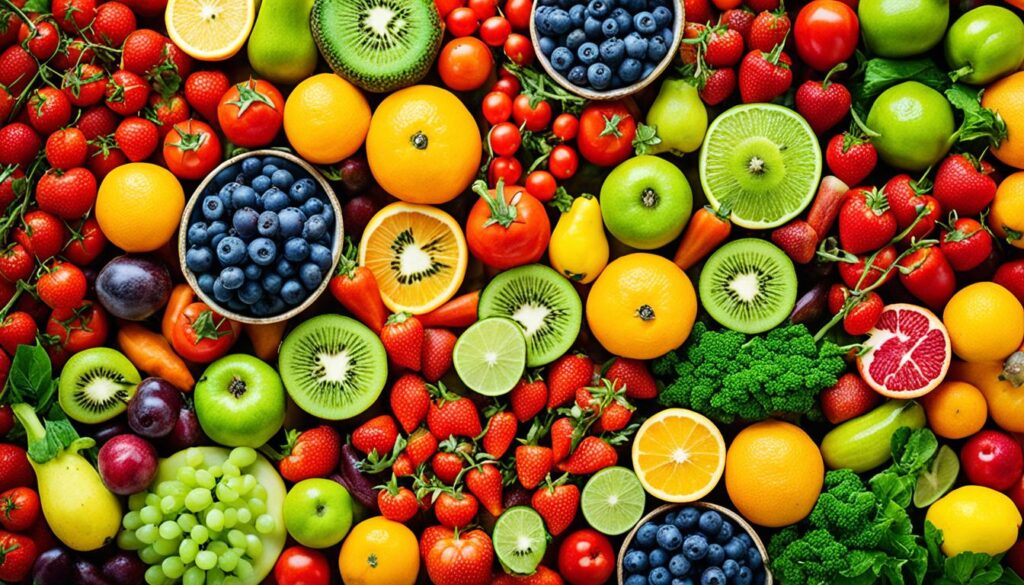
Phase 4 of the HCG diet is considered the long-term maintenance phase. It is the phase that individuals continue with for the rest of their lives. During this phase, I can continue to enjoy a balanced and healthy lifestyle while following the principles I learned during the HCG diet.
This phase emphasizes the importance of maintaining a healthy weight and making mindful food choices. It is crucial to continue practicing healthy eating habits and regular exercise to sustain long-term weight loss.
Key Takeaways:
- Phase 4 of the HCG diet is the long-term maintenance phase.
- During this phase, focus on maintaining a healthy weight.
- Continue making mindful food choices.
- Practice healthy eating habits and regular exercise.
“The long-term maintenance phase is an opportunity to integrate the habits I learned during the HCG diet into my everyday life. It’s about making sustainable choices that support my health and well-being.” – HCG diet participant
| Phase 4 – The Rest of Your Life | |
|---|---|
| Duration | For the rest of your life |
| Main Focus | Maintaining a healthy weight |
| Action Steps |
|
Gluten-Free Recipes
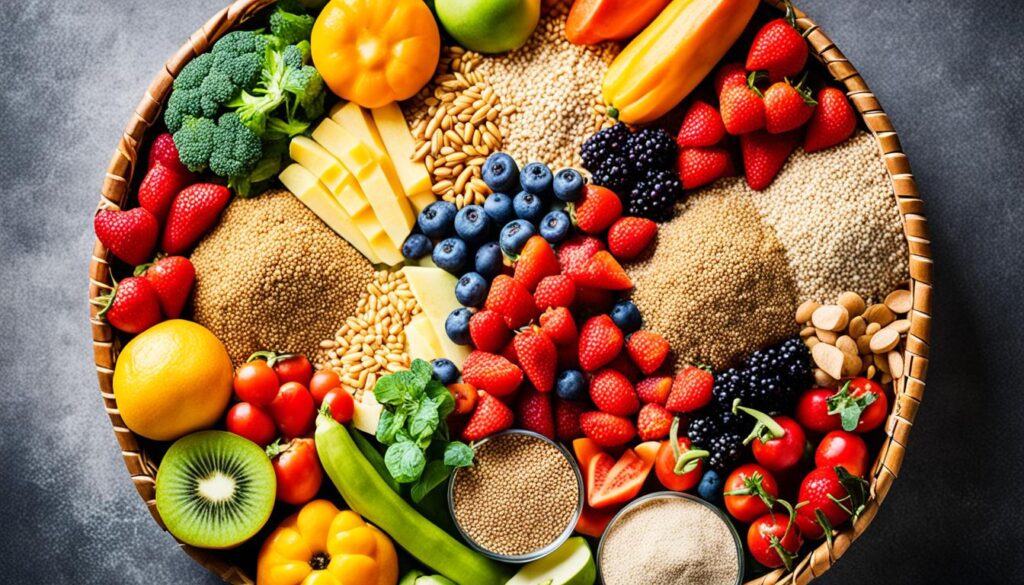
In addition to the comprehensive Gluten-Free HCG Diet Food List, I discovered a wide range of delicious gluten-free recipes that are perfect for individuals on the HCG diet. These recipes are not only gluten-free but also packed with flavors and nutrients to keep you satisfied throughout your diet journey. Whether you’re looking for a hearty meal or a quick snack, these gluten-free recipes have got you covered.
1. Gluten-Free Chicken Stir-Fry
If you’re craving a savory and protein-packed meal, try this gluten-free chicken stir-fry. Sauté tender chicken breast with a colorful medley of fresh vegetables like bell peppers, broccoli, and snap peas. Season with gluten-free tamari sauce, garlic, ginger, and a hint of chili flakes for a burst of flavor. Serve over cauliflower rice for a low-carb and gluten-free alternative.
2. Gluten-Free Vegetable Curry
Indulge in the aromatic and comforting flavors of this gluten-free vegetable curry. Sauté a medley of vegetables like cauliflower, carrots, and bell peppers in a fragrant blend of gluten-free curry paste, coconut milk, and spices. Let the flavors meld together as the vegetables become tender. Serve over quinoa or gluten-free naan bread for a satisfying gluten-free meal.
3. Gluten-Free Banana Bread
Satisfy your sweet tooth with this moist and delicious gluten-free banana bread. Mash ripe bananas and combine them with gluten-free flour, eggs, coconut oil, and a touch of cinnamon for a delightful treat. Bake until golden brown and enjoy a slice of warm banana bread with a cup of tea or as a quick on-the-go snack.
These gluten-free recipes not only cater to your dietary needs but also provide a delightful culinary experience. Incorporating these recipes into your gluten-free HCG diet can add variety and excitement to your meals while ensuring you stay on track with your weight loss goals.
Stay tuned for more gluten-free recipes and tips to enhance your gluten-free HCG diet experience!
Conclusion
After conducting thorough research and analysis, it is evident that the Ultimate Gluten-Free HCG Diet Food List is an invaluable asset for individuals embarking on a gluten-free HCG diet plan. This comprehensive food list not only outlines a wide range of gluten-free options but also provides detailed guidelines and tips for each phase of the diet.
By adhering to the gluten-free HCG diet and incorporating the recommended foods from the extensive food list, individuals can effectively achieve their weight loss goals while maintaining a healthy lifestyle. The carefully curated food list ensures that individuals have a plethora of gluten-free choices that are in line with the principles of the HCG diet.
Whether it’s selecting lean proteins, choosing from an assortment of vegetables and fruits, or finding suitable condiments, the Ultimate Gluten-Free HCG Diet Food List serves as a reliable companion throughout the diet journey. With this resource at hand, individuals can make informed decisions about their meals and confidently navigate the various phases of the HCG diet.
In conclusion, the Ultimate Gluten-Free HCG Diet Food List empowers individuals to embrace a gluten-free lifestyle while achieving their weight loss objectives. This invaluable guide equips individuals with the necessary knowledge and tools to make informed dietary choices and embark on a successful gluten-free HCG diet journey. By following the recommended foods and guidelines from the food list, individuals can embark on a transformative journey towards a healthier and happier lifestyle.
FAQ
What is the Ultimate Gluten-Free HCG Diet Food List Guide?
The Ultimate Gluten-Free HCG Diet Food List Guide is a comprehensive resource that provides a detailed list of gluten-free food options suitable for individuals on the HCG diet.
What is the HCG diet?
The HCG diet is a weight loss protocol developed by Dr. A.T.W. Simeons. It involves the use of the hormone Human Chorionic Gonadotropin (HCG) and various phases to achieve weight loss goals.
What is Phase 1 – Gorging/Loading?
Phase 1 of the HCG diet is known as the gorging or loading phase. It involves eating as much fatty and oily foods as possible to prepare the body for the low-calorie phase of the diet.
What is Phase 2 – Fat Burn?
Phase 2 of the HCG diet is the fat burn phase. It lasts for 21 days and involves consuming only 500 calories per day while using the HCG hormone to promote fat burning.
What foods are allowed on the HCG diet?
The HCG diet allows proteins such as lean meats, chicken breast, and seafood; vegetables like broccoli, spinach, and cucumbers; and fruits such as apples, oranges, and strawberries in limited quantities.
What should be avoided on the HCG diet?
Oils in personal care products, liquid makeup, sunburn, excessive exercise, and certain foods containing sugars and starches should be avoided on the HCG diet.
What are plateau breakers?
Plateau breakers are strategies used to overcome weight loss plateaus during the HCG diet. These include increasing water intake, adjusting protein intake, and checking condiments for hidden sugars.
How can progress be monitored on the HCG diet?
Progress on the HCG diet can be monitored using measurement charts to track body measurements and a tracking chart to record daily weight and observations.
What is Phase 3 – Maintenance Phase?
Phase 3 of the HCG diet is the maintenance phase. It involves gradually increasing calorie intake while still following HCG diet principles to stabilize weight.
What is Phase 4 – The Rest of Your Life?
Phase 4 is the long-term maintenance phase of the HCG diet. During this phase, individuals continue with the principles learned during the diet to maintain a healthy weight and lifestyle.
Are there gluten-free recipes available for the HCG diet?
Yes, there are various gluten-free recipes available that are suitable for individuals on the HCG diet and provide meal variety within the gluten-free restrictions.
How does the Ultimate Gluten-Free HCG Diet Food List Guide benefit individuals on a gluten-free HCG diet?
The Ultimate Gluten-Free HCG Diet Food List Guide serves as a valuable resource, providing a comprehensive list of gluten-free food options and guidelines specific to the HCG diet. It helps individuals follow the HCG diet while maintaining a gluten-free lifestyle to achieve their weight loss goals.

